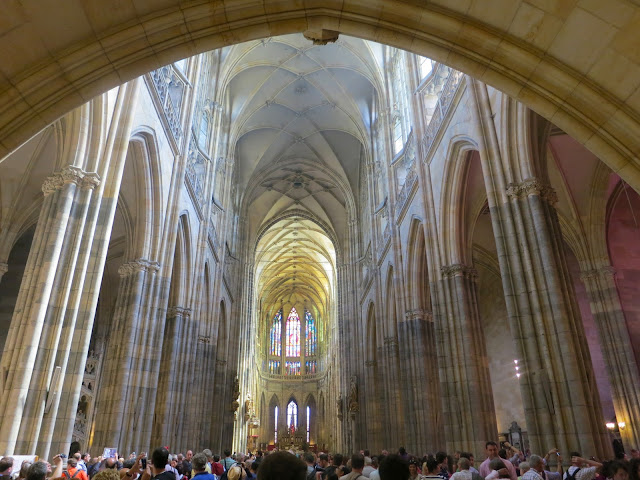If European cities were a necklace, Prague would be a diamond among the pearls. (Anonymous)
This morning we woke up at the insane hour of 5:00am with the sun already streaming through the windows of our hotel room. The combination of spring and Prague being so far north make for lots of daylight. It was still daylight last night at 9:00.
We met our guide this morning and headed out to Strahov Monastery which is located on a hill overlooking the city. We walked around admiring the building's architecture and looked out over the city from a great vantage point. Prague is called the "City of 100 Spires" and from here, you can tell how it got this name. There are dozens of church spires rising up over the red roofs dotting the city. Sadly, the city is one of (if not the most) agnostic city in Europe. The years the Communists ruled the country church attendance was discouraged. In fact, our guide told us his grandparents went to church before and during the Communist occupation and because of that, his mother (their daughter) was not allowed to attend university. I suppose an educated church-goer was seen as a threat to Communism. The churches are lovely buildings and are now mostly used as classical music venues.
Strahov Monastery
This city looks like a painter's canvas. It is splashed with bright reds, greens and yellows. Below are Tony and I with the city behind us. The spires of the Gothic Tyn church loom over my shoulder.
The Prague Castle district is rather large and is home to several famous buildings. Below is the Castle itself with the Cathedral of St Vitus in the background.
St Vitus Cathedral is awe-inspiring with its gargoyles and flying buttresses. My first glimpse inside took my breath away.

One part of the Castle District is the Golden Lane, a very small street with even smaller ancient houses. They look exactly like colorful playhouses or even doll houses. People actually lived here and for a short time Franz Kafka lived in No 22. It is said it was here that he got the inspiration for The Castle.
We then walked across the Charles Bridge to the Lennon Wall, a graffiti-filled wall begun in 1980 to memorialize John Lennon after his death. Prague at the time was still under Communist rule so each night the police would come and paint over the wall but each day the graffiti would reappear. We were told it was a way to express the desire for freedom which finally came in 1989 with the Velvet Revolution.
These locks are on many bridges in Europe. Lovers come to the bridge with a lock and key, vow undying love for each other, attach the lock to the iron work on the bridge and throw the key in the river.
An incredible site for all of us was the old Jewish quarter with the Jewish cemetery. Because Jews of Prague were for years forced to live in one little quarter, burying the dead became a difficulty. New soil would be brought in, spread over the existing graves, a new grave dug and then the two (or more) tombstones would share the space. Over time, over 10,000 Jews were buried in this cemetery, some graves going back as far as 800 years. Above, the men in our group had to wean yarmulkes for the tour.
We walked over to the Old Town Square after visiting the Jewish Quarter.
We stood with tons of other tourists to see the astronomical clock.
And we ended our touring day with pastries and ice cream at Mysak.
We walked home back over the Charles Bridge and got ready for dinner at Celeste which is at the top of the Frank Gehry dancing building. Our meal was delicious and afterwards we walked to the very top of the building for a fabulous view of the city.


























It really looks fabulous and interesting. I SO did not expect the John Lennon wall. The cemetery look very interesting too. Keep the posts coming!
ReplyDelete